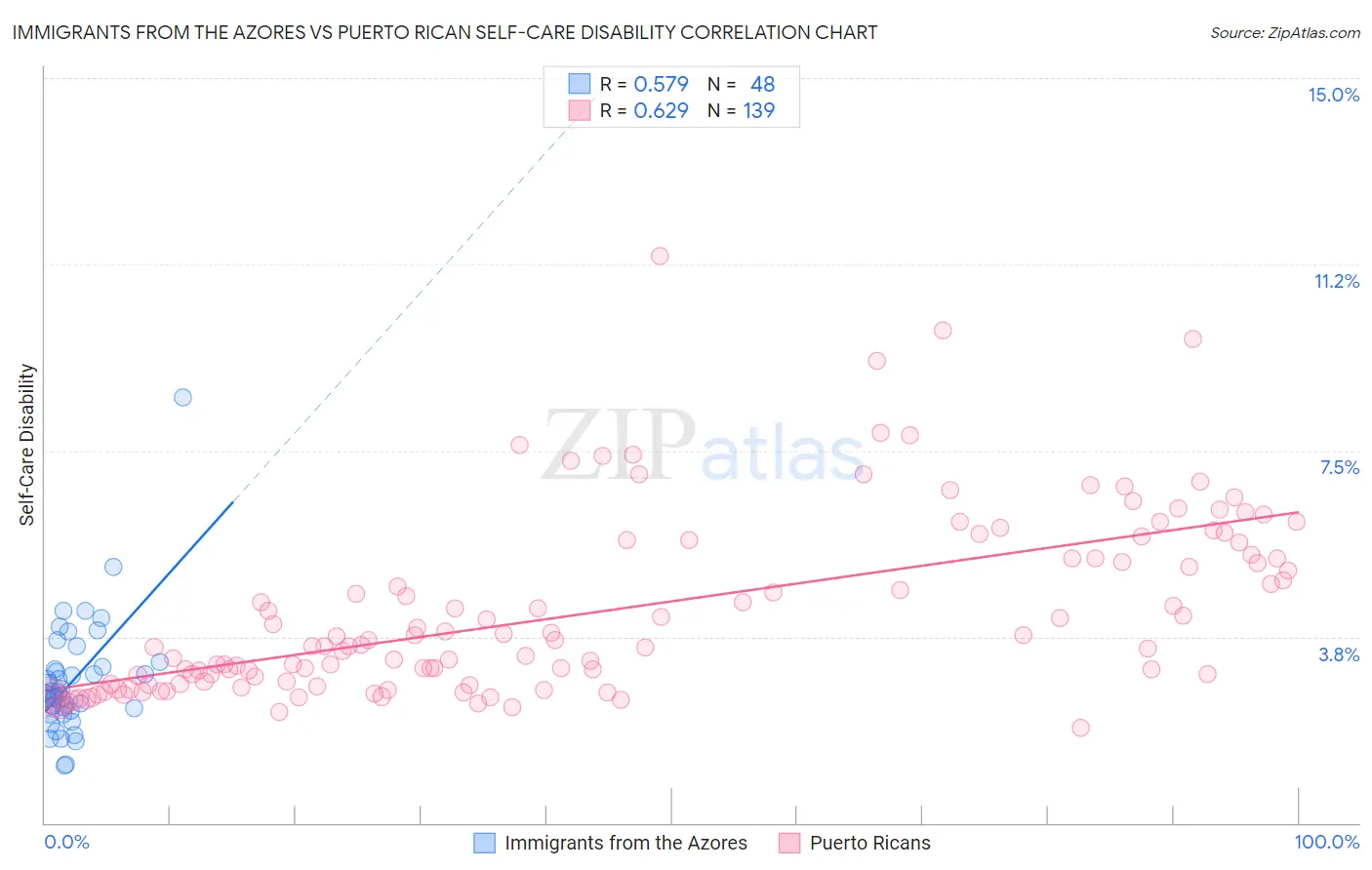Immigrants from the Azores vs Puerto Rican Self-Care Disability
COMPARE
Immigrants from the Azores
Puerto Rican
Self-Care Disability
Self-Care Disability Comparison
Immigrants from the Azores
Puerto Ricans
3.0%
SELF-CARE DISABILITY
0.0/ 100
METRIC RATING
335th/ 347
METRIC RANK
3.7%
SELF-CARE DISABILITY
0.0/ 100
METRIC RATING
346th/ 347
METRIC RANK
Immigrants from the Azores vs Puerto Rican Self-Care Disability Correlation Chart
The statistical analysis conducted on geographies consisting of 46,255,700 people shows a substantial positive correlation between the proportion of Immigrants from the Azores and percentage of population with self-care disability in the United States with a correlation coefficient (R) of 0.579 and weighted average of 3.0%. Similarly, the statistical analysis conducted on geographies consisting of 527,012,909 people shows a significant positive correlation between the proportion of Puerto Ricans and percentage of population with self-care disability in the United States with a correlation coefficient (R) of 0.629 and weighted average of 3.7%, a difference of 23.1%.

Self-Care Disability Correlation Summary
| Measurement | Immigrants from the Azores | Puerto Rican |
| Minimum | 1.1% | 1.9% |
| Maximum | 8.6% | 11.4% |
| Range | 7.4% | 9.5% |
| Mean | 2.9% | 4.3% |
| Median | 2.6% | 3.6% |
| Interquartile 25% (IQ1) | 2.3% | 2.8% |
| Interquartile 75% (IQ3) | 3.1% | 5.3% |
| Interquartile Range (IQR) | 0.84% | 2.5% |
| Standard Deviation (Sample) | 1.2% | 1.8% |
| Standard Deviation (Population) | 1.2% | 1.8% |
Demographics Similar to Immigrants from the Azores and Puerto Ricans by Self-Care Disability
In terms of self-care disability, the demographic groups most similar to Immigrants from the Azores are Houma (3.0%, a difference of 0.050%), Dutch West Indian (3.0%, a difference of 0.12%), Immigrants from Yemen (3.0%, a difference of 0.16%), Kiowa (3.0%, a difference of 0.35%), and Lumbee (3.0%, a difference of 0.71%). Similarly, the demographic groups most similar to Puerto Ricans are Armenian (3.4%, a difference of 8.0%), Pueblo (3.3%, a difference of 12.8%), Immigrants from Armenia (4.2%, a difference of 13.7%), Tohono O'odham (3.1%, a difference of 18.0%), and Colville (3.1%, a difference of 18.1%).
| Demographics | Rating | Rank | Self-Care Disability |
| Hopi | 0.0 /100 | #328 | Tragic 2.9% |
| Cajuns | 0.0 /100 | #329 | Tragic 2.9% |
| Nepalese | 0.0 /100 | #330 | Tragic 3.0% |
| Lumbee | 0.0 /100 | #331 | Tragic 3.0% |
| Kiowa | 0.0 /100 | #332 | Tragic 3.0% |
| Dutch West Indians | 0.0 /100 | #333 | Tragic 3.0% |
| Houma | 0.0 /100 | #334 | Tragic 3.0% |
| Immigrants | Azores | 0.0 /100 | #335 | Tragic 3.0% |
| Immigrants | Yemen | 0.0 /100 | #336 | Tragic 3.0% |
| Choctaw | 0.0 /100 | #337 | Tragic 3.0% |
| Cape Verdeans | 0.0 /100 | #338 | Tragic 3.0% |
| Immigrants | Dominican Republic | 0.0 /100 | #339 | Tragic 3.0% |
| Immigrants | Cabo Verde | 0.0 /100 | #340 | Tragic 3.1% |
| Dominicans | 0.0 /100 | #341 | Tragic 3.1% |
| Colville | 0.0 /100 | #342 | Tragic 3.1% |
| Tohono O'odham | 0.0 /100 | #343 | Tragic 3.1% |
| Pueblo | 0.0 /100 | #344 | Tragic 3.3% |
| Armenians | 0.0 /100 | #345 | Tragic 3.4% |
| Puerto Ricans | 0.0 /100 | #346 | Tragic 3.7% |
| Immigrants | Armenia | 0.0 /100 | #347 | Tragic 4.2% |